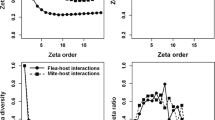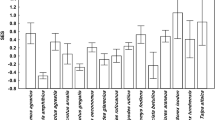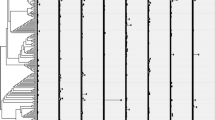Abstract
We studied compositional turnover in communities of fleas and mites harboured by small mammals using zeta diversity metric (similarity between multiple communities) and asked whether the patterns of zeta diversity decline with an increase in the number of communities differ between taxa and hierarchical scales [infracommunities (parasite assemblages on individual hosts), component communities (parasite assemblages harboured by host populations), and compound communities (all parasite species in a locality)]. The average number of shared species declined with an increasing number of communities (zeta order). It attained zero at higher orders in infracommunities of both taxa with the shape of the zeta decline being best fitted by the negative exponential function, and the retention rate curves being modal. In contrast, zeta diversity values for compound communities of mites and fleas did not attain zero at higher zeta orders, and the form of the zeta decline was best fitted by the power-law function, whereas the retention rate curves were asymptotic. In component communities, the form of zeta decline was best fitted by either exponential or power-law function in dependence of whether communities were considered within a host across localities or across hosts within a locality and whether ubiquitous species were taken into account. Our main conclusions are that (a) the rules governing compositional turnover in parasite communities for the lowest and the highest hierarchical scales are taxon-invariant but scale-dependent and (b) species composition of infracommunities is mainly driven by stochastic assembly processed, whereas that of compound communities is mainly driven by niche-based processes.





Similar content being viewed by others
References
Baird HP, Janion-Scheepers C, Stevens MI, Leihy RI, Chown SL (2019) The ecological biogeography of indigenous and introduced Antarctic springtails. J Biogeogr 46:1959–1973. https://doi.org/10.1111/jbi.13639
Baselga A (2010) Partitioning the turnover and nestedness components of beta diversity. Glob Ecol Biogeogr 19:134–143. https://doi.org/10.1111/j.1466-8238.2009.00490.x
Britton AW, Day JJ, Doble CJ, Ngatunga BP, Kemp KM, Carbone C, Murrell DJ (2017) Terrestrial-focused protected areas are effective for conservation of freshwater fish diversity in Lake Tanganyika. Biol Conserv 212:120–129
Brown JM (1987) Variation in desert rodent guilds: patterns, processes and scales. In: Gee JHR, Giller PS (eds) Organization of communities: past and present. Blackwell, Oxford, pp 185–203
Browne RA (1981) Lakes as islands: biogeographic distribution, turnover rates, and species composition in the lakes of central New York. J Biogeogr 8:75–83. https://doi.org/10.2307/2844594
Buckle AP (1978) The mark, release and recapture of fleas in a wild population of woodmice, Apodemus sylvaticus. J Zool 186:563–567
Chao A, Gotelli NJ, Hsieh TC, Sander EL, Ma KH, Colwell RK, Ellison AM (2014) Rarefaction and extrapolation with Hill numbers: a framework for sampling and estimation in species diversity studies. Ecol Monogr 84:45–67. https://doi.org/10.1890/13-0133.1
Colwell RK, Chao A, Gotelli NJ, Lin S-Y, Mao CX, Chazdon RL, Longino JT (2012) Models and estimators linking individual-based and sample-based rarefaction, extrapolation and comparison of assemblages. J Plant Ecol 5:3–21. https://doi.org/10.1093/jpe/rtr044
Fellis KJ, Esch GW (2005) Autogenic-allogenic status affects interpond community similarity and species-area relationship of macroparasites in the bluegill sunfish, Lepomis macrochirus, from a series of freshwater ponds in the Piedmont area of North Carolina. J Parasitol 91:764–767. https://doi.org/10.1645/GE-451R.1
Holmes JC, Price PW (1986) Communities of parasites. In: Kittawa J, Anderson DJ (eds) Community ecology: pattern and process. Blackwell, Oxford, pp 187–213
Hsieh TC, Ma KH, Chao A (2016) iNEXT: an R package for rarefaction and extrapolation of species diversity (Hill numbers). Methods Ecol Evol 7:1451–1456. https://doi.org/10.1111/2041-210X.12613
Hsieh TC, Ma KH, Chao A (2020) iNEXT: iNterpolation and EXTrapolation for species diversity. R package version 2.0.20 https://chao.stat.nthu.edu.tw/wordpress/software-download/
Hu M, Wang C, Liu Y, Zhang X, Jian S (2019) Fish species composition, distribution and community structure in the lower reaches of Ganjiang River, Jiangxi. China Sci Rep 9:10100. https://doi.org/10.1038/s41598-019-46600-2
Hui C, McGeoch MA (2014) Zeta diversity as a concept and metric that unifies incidence-based biodiversity patterns. Am Nat 184:684–694. https://doi.org/10.1086/678125
Hui C, Vermeulen W, Durrheim G (2018) Quantifying multiple-site compositional turnover in an Afrotemperate forest, using zeta diversity. For Ecosyst 5:15. https://doi.org/10.1186/s40663-018-0135-1
Ingram T, Shurin JB (2009) Trait-based assembly and phylogenetic structure in northeast Pacific rockfish assemblages. Ecology 90:2444–2453. https://doi.org/10.1890/08-1841.1
Itow S (1991) Species turnover and diversity patterns along an evergeen broad-leaved forest coenocline. J Veget Sci 2:477–484. https://doi.org/10.2307/3236029
Korallo-Vinarskaya NP, Vinarski MV, Khokhlova IS, Krasnov BR (2013) Body size and coexistence in gamasid mites parasitic on small mammals: null model analyses at three hierarchical scales. Ecography 36:508–517. https://doi.org/10.1111/j.1600-0587.2012.07779.x
Krasnov BR (2008) Functional and evolutionary ecology of fleas. A model for ecological parasitology. Cambridge University Press, Cambridge. https://doi.org/10.1017/CBO9780511542688
Krasnov BR, Khokhlova IS (2001) The effect of behavioural interactions on the transfer of fleas (Siphonaptera) between two rodent species. J Vector Ecol 26:181–190
Krasnov BR, Khokhlova IS, Shenbrot GI (2004) Sampling fleas: the reliability of host infestation data. Med Vet Entomol 18:232–240. https://doi.org/10.1111/j.0269-283x.2004.00500.x
Krasnov BR, Shenbrot GI, Mouillot D, Khokhlova IS, Poulin R (2005a) Spatial variation in species diversity and composition of flea assemblages in small mammalian hosts: geographic distance or faunal similarity? J Biogeogr 32:633–644. https://doi.org/10.1111/j.1365-2699.2004.01206.x
Krasnov BR, Poulin R, Shenbrot GI, Mouillot D, Khokhlova IS (2005b) Host specificity and geographic range in haematophagous ectoparasites. Oikos 108:449–456
Krasnov BR, Shenbrot GI, Khokhlova IS, Hawlena H, Degen AA (2006) Temporal variation in parasite infestation of a host individual: does a parasite-free host remain uninfested permanently? Paras Res 99:541–545. https://doi.org/10.1007/s00436-006-0201-4
Krasnov BR, Stanko M, Khokhlova IS, Shenbrot GI, Morand S, Korallo-Vinarskaya NP, Vinarski MV (2011) Nestedness and β-diversity in ectoparasite assemblages of small mammalian hosts: effects of parasite affinity, host biology and scale. Oikos 120:630–639. https://doi.org/10.1111/j.1600-0706.2010.19072.x
Krasnov BR, Shenbrot GI, Khokhlova IS, Stanko M, Morand S, Mouillot D (2015) Assembly rules of ectoparasite communities across scales: combining patterns of abiotic factors, host composition, geographic space, phylogeny and traits. Ecography 38:184–197. https://doi.org/10.1111/ecog.00915
Krasnov BR, Shenbrot GI, Korallo-Vinarskaya NP, Vinarski MV, van der Mescht L, Warburton EM, Khokhlova IS (2019a) Do the pattern and strength of species associations in ectoparasite communities conform to biogeographic rules? Parasitol Res 118:1113–1125. https://doi.org/10.1007/s00436-019-06255-4
Krasnov BR, Shenbrot GI, Korallo-Vinarskaya NP, Vinarski MV, Warburton EM, Khokhlova IS (2019b) The effects of environment, hosts and space on compositional, phylogenetic and functional beta-diversity in two taxa of arthropod ectoparasites. Parasitol Res 118:2107–2120. https://doi.org/10.1007/s00436-019-06371-1
Kunin WE, Harte J, He F, Hui C, Jobe RT, Ostling A, Polce H, Šizling A, Smith AB, Smith K, Smart SM, Storch D, Tjørve E, Ugland KI, Ulrich W, Varma V (2018) Upscaling biodiversity: estimating the species–area relationship from small samples. Ecol Monogr 88:170–187. https://doi.org/10.1002/ecm.1284
Labidi I, Errouissi F, Nouira S (2012) Spatial and temporal variation in species composition, diversity, and structure of Mediterranean dung beetle assemblages (Coleoptera: Scarabaeidae) across a bioclimatic gradient. Environ Entomol 41:785–801. https://doi.org/10.1603/EN11278
Latombe G, Hui C, McGeoch MA (2017) Multi-site generalised dissimilarity modelling: using zeta diversity to differentiate drivers of turnover in rare and widespread species. Methods Ecol Evol 8:431–442. https://doi.org/10.1111/2041-210X.12756
Latombe G, Richardson DM, Pyšek P, Kučera T, Hui C (2018a) Drivers of species turnover vary with species commonness for native and alien plants with different residence times. Ecology 99:2763–2775. https://doi.org/10.1002/ecy.2528
Latombe G, McGeoch MA, Nipperess D, Hui C (2018b) Zetadiv: functions to compute compositional turnover using zeta diversity. R package version 1.1.1. https://CRAN.R-project.org/package=zetadiv
Latombe G, Roura-Pascual N, Hui C (2019) Similar compositional turnover but distinct insular environmental and geographical drivers of native and exotic ants in two oceans. J Biogeogr 46:2299–2310. https://doi.org/10.1111/jbi.13671
Lazarina M, Kallimanis AS, Dimopoulos P, Psaralexi M, Michailidou D-E, Sgardelis SP (2019) Patterns and drivers of species richness and turnover of neo-endemic and palaeo-endemic vascular plants in a Mediterranean hotspot: the case of Crete. Greece J Biol Res-Thessaloniki 26:12. https://doi.org/10.1186/s40709-019-0106-x
Leihy RI, Duffy GA, Chown SL (2018) Species richness and turnover among indigenous and introduced plants and insects of the Southern Ocean Islands. Ecosphere 9:e02358. https://doi.org/10.1002/ecs2.2358
Maestri R, Shenbrot GI, Krasnov BR (2017) Parasite beta diversity, host beta diversity and environment: application of two approaches to reveal patterns of flea species turnover in Mongolia. J Biogeogr 44:1880–1890. https://doi.org/10.1111/jbi.13025
Manu M, Băncilă RI, Onete M (2013) Soil mite communities (Acari: Gamasina) from different ecosystem types from Romania. Belg J Zool 143:30–41
Manu M, Iordache V, Băncilă RI, Bodescu F, Onete M (2015) The influence of environmental variables on soil mite communities (Acari: Mesostigmata) from overgrazed grassland ecosystems—Romania. Ital J Zool 83:89–97. https://doi.org/10.1080/11250003.2015.1091897
Marshall AG (1981) The ecology of ectoparasitic insects. Acad Press, London
Mayamba A, Byamungu RM, Makundi RH, Kimaro DH, Isabirye M, Massawe AW, Kifumba D, Nakiyemba A, Leirs H, Mdangi ME, Isabirye BE, Mulungu LS (2019) Species composition and community structure of small pest rodents (Muridae) in cultivated and fallow fields in maize-growing areas in Mayuge district, Eastern Uganda. Ecol Evol 9:7849–7860. https://doi.org/10.1002/ece3.5371
McGeoch MA, Latombe G, Andrew NR, Nakagawa S, Nipperess DA, Roigé M, Marzinelli EM, Campbell AH, Vergés A, Thomas T, Steinberg PD, Selwood KE, Henriksen ME, Hui C (2019) Measuring continuous compositional change using decline and decay in zeta diversity. Ecology 100:e02832. https://doi.org/10.1002/ecy.2832
van der Mescht L, Krasnov BR, Matthee CA, Matthee S (2016) Community structure of fleas within and among populations of three closely related rodent hosts: nestedness and beta-diversity. Parasitology 143:1268–1278. https://doi.org/10.1017/S0031182016000664
van der Mescht L, Warburton EM, Khokhlova IS, Stanko M, Vinarski MV, Korallo-Vinarskaya NP, Krasnov BR (2018) Biogeography of parasite abundance: latitudinal gradient and distance decay of similarity in the abundance of fleas and mites parasitic on small mammals in the Palearctic at three spatial scales. Int J Parasitol 48:857–866. https://doi.org/10.1016/j.ijpara.2018.04.005
Morand S, Rohde K, Hayward C (2002) Order in ectoparasite communities of marine fish is explained by epidemiological processes. Parasitology 124:S57–S63. https://doi.org/10.1017/s0031182002001464
Patterson BD, Meserve PL, Lang BK (1989) Distribution and abundance of small mammals along an elevation transect in temperate rainforests of Chile. J Mammal 70:67–78. https://doi.org/10.2307/1381670
Pearman PB (2002) The scale of community structure: habitat variation and avian guilds in tropical forest understory. Ecol Monogr 72:19–39. https://doi.org/10.1890/0012-9615(2002)072[0019:TSOCSH]2.0.CO;2
Poulin R (2007) Evolutionary ecology of parasites: from individuals to communities, 2nd edn. Princeton University Press, Princeton
Poulin R, Krasnov BR, Mouillot D (2011) Host specificity in phylogenetic and geographic space. Trends Parasitol 27:355–361. https://doi.org/10.1016/j.pt.2011.05.003
R Core Team (2018). R: a language and environment for statistical computing. R Foundation for Statistical Computing, Vienna, Austria. URL https://www.R-project.org/
Radovsky FJ (1985) Evolution of mammalian mesostigmatid mites. In: Kim KC (ed) Coevolution of parasitic arthropods and mammals. Wiley, New York, pp 441–504
Rödl P (1979) Investigation of the transfer of fleas among small mammals using radioactive phosphorus. Folia Parasitol 26:265–274
Roigé M, McGeoch A, Hui C, Worner S (2017) Cluster validity and uncertainty assessment for self-organizing map pest profile analysis. Methods Ecol Evol 8:349–357. https://doi.org/10.1111/2041-210X.12669
Ryckman RE (1971) Plague vector studies. Part I. The rate of transfer of fleas among Citellus, Rattus and Sylvilagus under field conditions in southern California. J Med Entomol 8:535–540. https://doi.org/10.1093/jmedent/8.5.535
Shenbrot GI, Krasnov BR, Lu L (2007) Geographical range size and host specificity in ectoparasites: a case study with Amphipsylla fleas and rodent hosts. J Biogeogr 34:1679–1690. https://doi.org/10.1111/j.1365-2699.2007.01736.x
Shurin JB (2007) How is diversity related to species turnover through time? Oikos 116:957–965. https://doi.org/10.1111/j.0030-1299.2007.15751.x
Simons AL, Mazor R, Stein ED, Nuzhdin S (2019) Using alpha, beta, and zeta diversity in describing the health of stream-based benthic macroinvertebrate communities. Ecol Appl 29:e01896. https://doi.org/10.1002/eap.1896
Socolar JB, Gilroy JJ, Kunin WE, Edward DP (2016) How should beta-diversity inform biodiversity conservation? Trends Ecol Evol 31:67–80. https://doi.org/10.1016/j.tree.2015.11.005
Surkova EN, Korallo-Vinarskaya NP, Vinarski MV, van der Mescht L, Warburton EM, Khokhlova IS, Krasnov BR (2018) Body size distribution in flea communities harboured by Siberian small mammals as affected by host species, host sex and scale: scale matters the most. Evol Ecol 32:643–662. https://doi.org/10.1007/s10682-018-9955-2
Suzán G, García-Peña GE, Castro-Arellano I, Rico O, Rubio AV, Tolsá MJ, Roche B, Hosseini PR, Rizzoli A, Murray KA, Zambrana-Torrelio C, Vittecoq M, Bailly X, Aguirre AA, Daszak P, Prieur-Richard A-H, Mills JN, Guégan J-F (2015) Metacommunity and phylogenetic structure determine wildlife and zoonotic infectious disease patterns in time and space. Ecol Evol 5:865–873. https://doi.org/10.1002/ece3.1404
Timi J, Lanfranchia A, Lukue JL (2010) Similarity in parasite communities of the teleost fish Pinguipes brasilianus in the southwestern Atlantic: infracommunities as a tool to detect geographical patterns. Int J Parasitol 40:243–254. https://doi.org/10.1016/j.ijpara.2009.07.006
Vinarski MV, Korallo-Vinarskaya NP (2016) An annotated catalogue of the gamasid mites associated with small mammals in Asiatic Russia. The family Laelapidae s. str. (Acari: Mesostigmata: Gamasina). Zootaxa 4111:223–245. https://doi.org/10.11646/zootaxa.4111.3.2
Vinarski MV, Korallo-Vinarskaya NP (2017) An annotated catalogue of the gamasid mites associated with small mammals in Asiatic Russia. The family Haemogamasidae (Acari: Mesostigmata: Gamasina). Zootaxa 4273:001–018. https://doi.org/10.11646/zootaxa.4273.1.1
Vinarski MV, Korallo NP, Krasnov BR, Shenbrot GI, Poulin R (2007) Decay of similarity of gamasid mite assemblages parasitic on Palaearctic small mammals: geographic distance, host species composition or environment? J Biogeogr 34:1691–1700. https://doi.org/10.1111/j.1365-2699.2007.01735.x
Warburton EM, Kohler SL, Vonhof MJ (2016) Patterns of parasite community dissimilarity: the significant role of land use and lack of distance-decay in a bat–helminth system. Oikos 125:374–385. https://doi.org/10.1111/oik.02313
Webb CT, Hoeting JA, Ames GM, Pyne MI, LeRoy PN (2010) A structured and dynamic framework to advance traits-based theory and prediction in ecology. Ecol Lett 13:267–283. https://doi.org/10.1111/j.1461-0248.2010.01444.x
Weiher E, Freund D, Bunton T, Stefanski A, Lee T, Bentivenga S (2011) Advances, challenges and a developing synthesis of ecological community assembly theory. Phil Trans R Soc B 366:2403–2413. https://doi.org/10.1098/rstb.2011.0056
Whittaker RH (1960) Vegetation of the Siskiyou Mountains, Oregon and California. Ecol Monogr 30:279–338. https://doi.org/10.2307/1943563
Williams GL, Smiley RL, Redington BC (1978) A taxonomic study of the genus Haemogamasus in North America, with descriptions of two new species (Acari: Mesostigmata, Laelaptidae). Int J Acarol 4:235–273. https://doi.org/10.1080/01647957808683122
Acknowledgements
We thank Guillaume Latombe and two anonymous referees for their helpful comments on earlier version of the manuscript. This is publication no. 1066 of the Mitrani Department of Desert Ecology.
Funding
This study was partly supported by the Israel Science Foundation (Grant number 149/17 to BRK and ISK).
Author information
Authors and Affiliations
Contributions
BRK and ISK conceived of the study. MVV and NPK-V collected data. BRK and ISK analysed data and drafted the manuscript. All authors finalized the manuscript.
Corresponding author
Ethics declarations
Conflict of interest
The authors declare that they have no conflict of interest.
Ethical approval
This article relies on previously collected data deposited at the Omsk the Omsk Research Institute of Natural Foci Infections (Omsk, Russia) and does not contain experiments with human participants or animals performed by any of the authors. For this type of study, formal consent is not required.
Additional information
Communicated by Evan Siemann.
Electronic supplementary material
Below is the link to the electronic supplementary material.
Rights and permissions
About this article
Cite this article
Krasnov, B.R., Vinarski, M.V., Korallo-Vinarskaya, N.P. et al. Patterns of zeta diversity in ectoparasite communities harboured by small mammals at three hierarchical scales: taxon-invariance and scale-dependence. Oecologia 192, 1057–1071 (2020). https://doi.org/10.1007/s00442-020-04641-9
Received:
Accepted:
Published:
Issue Date:
DOI: https://doi.org/10.1007/s00442-020-04641-9




